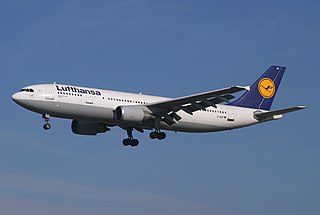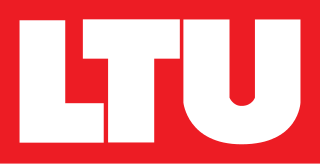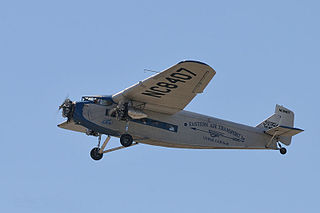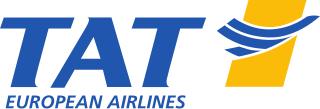
An airline is a company that provides air transport services for traveling passengers and freight. Airlines use aircraft to supply these services and may form partnerships or alliances with other airlines for codeshare agreements, in which they both offer and operate the same flight. Generally, airline companies are recognized with an air operating certificate or license issued by a governmental aviation body. Airlines may be scheduled or charter operators.

The Airbus A300 is a wide-body airliner developed and manufactured by Airbus. In September 1967, aircraft manufacturers in the United Kingdom, France, and West Germany signed a memorandum of understanding to develop a large airliner. West Germany and France reached an agreement on 29 May 1969 after the British withdrew from the project on 10 April 1969. European collaborative aerospace manufacturer Airbus Industrie was formally created on 18 December 1970 to develop and produce it. The prototype first flew on 28 October 1972.

The Boeing 747 is a large, long-range wide-body airliner designed and manufactured by Boeing Commercial Airplanes in the United States. After introducing the 707 in October 1958, Pan Am wanted a jet 2+1⁄2 times its size, to reduce its seat cost by 30% to democratize air travel. In 1965, Joe Sutter left the 737 development program to design the 747, the first twin-aisle airliner. In April 1966, Pan Am ordered 25 Boeing 747-100 aircraft and in late 1966, Pratt & Whitney agreed to develop its JT9D engine, a high-bypass turbofan. On September 30, 1968, the first 747 was rolled out of the custom-built Everett Plant, the world's largest building by volume. The first flight took place on February 9, 1969, and the 747 was certified in December of that year. It entered service with Pan Am on January 22, 1970. The 747 was the first airplane dubbed "Jumbo Jet", the first wide-body airliner.

The Boeing 777, commonly referred to as the Triple Seven, is an American long-range wide-body airliner developed and manufactured by Boeing Commercial Airplanes. It is the world's largest twinjet. The 777 was designed to bridge the gap between Boeing's other wide body airplanes, the twin-engined 767 and quad-engined 747, and to replace older DC-10s and L-1011 trijets. Developed in consultation with eight major airlines, with a first meeting in January 1990, the program was launched on October 14, 1990, with an order from United Airlines. The prototype was rolled out on April 9, 1994, and first flew on June 12, 1994. The 777 entered service with the launch customer, United Airlines, on June 7, 1995. Longer range variants were launched on February 29, 2000, and were first delivered on April 29, 2004.

Stockholm Arlanda Airport is an international airport located in the Sigtuna Municipality of Sweden, near the town of Märsta, 37 kilometres (23 mi) north of Stockholm and nearly 40 kilometres (25 mi) south-east of Uppsala. The airport is located within Stockholm County and the province of Uppland. It is the largest airport in Sweden and the third-largest airport in the Nordic countries. The airport is the major gateway to international air travel for large parts of Sweden. Arlanda Airport was used by close to 27 million passengers in 2017, with 21.2 million international passengers and 5.5 million domestic.

The Airbus A340 is a long-range, wide-body passenger airliner that was developed and produced by Airbus. In the mid-1970s, Airbus conceived several derivatives of the A300, its first airliner, and developed the A340 quadjet in parallel with the A330 twinjet. In June 1987, Airbus launched both designs with their first orders and the A340-300 took its maiden flight on 25 October 1991. It was certified along with the A340-200 on 22 December 1992 and both versions entered service in March 1993 with launch customers Lufthansa and Air France. The larger A340-500/600 were launched on 8 December 1997; the A340-600 flew for the first time on 23 April 2001 and entered service on 1 August 2002.

A wide-body aircraft, also known as a twin-aisle aircraft, is an airliner with a fuselage wide enough to accommodate two passenger aisles with seven or more seats abreast. The typical fuselage diameter is 5 to 6 m. In the typical wide-body economy cabin, passengers are seated seven to ten abreast, allowing a total capacity of 200 to 850 passengers. The largest wide-body aircraft are over 6 m (20 ft) wide, and can accommodate up to eleven passengers abreast in high-density configurations.

Libyan Airlines, formerly known as Libyan Arab Airlines over several decades, is the flag carrier of Libya. Based in Tripoli, it operates scheduled passenger and cargo services within Libya and to Europe, North Africa and the Middle East, the majority of which leave from Tripoli International Airport. Benina International Airport in Benghazi serves as a secondary base. Libyan Airlines also operates Hajj services. The company is wholly owned by the government of Libya.

Berlin Tegel "Otto Lilienthal" Airport was the primary international airport of Berlin, the federal capital of Germany. The airport was named after Otto Lilienthal and was the fourth busiest airport in Germany, with over 24 million passengers in 2019. In 2016, Tegel handled over 60% of all airline passenger traffic in Berlin. The airport served as a base for Eurowings, Ryanair as well as easyJet. It featured flights to several European metropolitan and leisure destinations as well as some intercontinental routes. It was situated in Tegel, a section of the northern borough of Reinickendorf, eight kilometres northwest of the city centre of Berlin. Tegel Airport was notable for its hexagonal main terminal building around an open square, which made walking distances as short as 30 m (100 ft) from the aircraft to the terminal exit.

LTU, legally incorporated as LTU Lufttransport-Unternehmen GmbH, was a German leisure airline headquartered in Düsseldorf. It operated medium and long-haul routes and maintained hubs at Düsseldorf Airport, Munich Airport and Berlin-Tegel Airport. LTU was acquired by Air Berlin in 2007. Use of the LTU brand ceased in 2009, and LTU itself was dissolved by April 2011.

The Sud Aviation SE 210 Caravelle is a French jet airliner produced by Sud Aviation. It was developed by SNCASE in the early 1950s and made its maiden flight on 27 May 1955. It included some de Havilland designs and components developed for the de Havilland Comet. SNCASE merged into the larger Sud Aviation conglomerate before the aircraft entered revenue service on 26 April 1959 with Scandinavian Airlines System (SAS); 282 were built until production ended in 1972. It was ordered by airlines on every continent and operated until its retirement in 2005.

The Fokker 100 is a regional jet produced by Fokker in the Netherlands. The Fokker 100 is based on the Fokker F28 with a fuselage stretched by 18.8 ft (5.7 m) to seat up to 109 passengers, up from 85. It is powered by two newer Rolls-Royce Tay turbofans, and it has an updated glass cockpit and a wider wing and tail for increased maximum weights.
Transportes Aeromar, S.A. de C.V, doing business as Aeromar, is a Mexican airline that operates scheduled domestic services in Mexico and international services to the United States, Guatemala, and Honduras. Its main base is Mexico City International Airport.

The Ford Trimotor is an American three-engined transport aircraft. Production started in 1925 by the companies of Henry Ford and ended on June 7, 1933. A total of 199 Ford Trimotors were made. It was designed for the civil aviation market, but also saw service with military units.

The Fokker 50 is a turboprop-powered airliner, designed as an improved version of the successful Fokker F27 Friendship. The Fokker 60 is a stretched freighter version of the Fokker 50. Both aircraft were manufactured and supported by Dutch aircraft manufacturer Fokker.

The Boeing 747SP is a shortened version of the Boeing 747 wide-body airliner, designed for a longer range. Boeing needed a smaller aircraft to compete with the McDonnell Douglas DC-10 and Lockheed L-1011 TriStar tri-jet wide-bodies, introduced in 1971/1972. Pan Am requested a 747-100 derivative to fly between New York and the Middle East, a request also shared by Iran Air, and the first order came from Pan Am in 1973.

Transport Aérien Transrégional was a French regional airline with its head office on the grounds of Tours Val de Loire Airport in Tours. It was formed in 1968 as Touraine Air Transport (TAT) by M. Marchais. Air France acquired a minority stake in the airline in 1989. Between 1993 and 1996 the company was gradually taken over by British Airways. It subsequently merged with Air Liberté.
Det Danske Luftfartselskab A/S or DDL, trading in English as Danish Air Lines, was Denmark's national airline from 1918 until it merged to create Scandinavian Airlines System (SAS) in 1951. DDL was established on 29 October 1918, but started its first scheduled route on 7 August 1920.
DHL Aviation is a division of DHL responsible for providing air transport capacity. It is not a single airline but instead refers to several airlines which are either owned, co owned or chartered by DHL Express. Deutsche Post World Net fully rebranded to Deutsche Post DHL (DPDHL) in March 2009.
TAP Air Portugal is the state-owned flag carrier airline of Portugal, headquartered at Lisbon Airport which also serves as its hub. TAP – Transportes Aéreos Portugueses – has been a member of the Star Alliance since 2005 and operates on average 2,500 flights a week to 90 destinations in 34 countries worldwide. The company has a fleet of 100 aircraft, all of which are manufactured by Airbus with the exception of 22 made by Embraer and ATR, operating on behalf of the regional airline TAP Express.

















